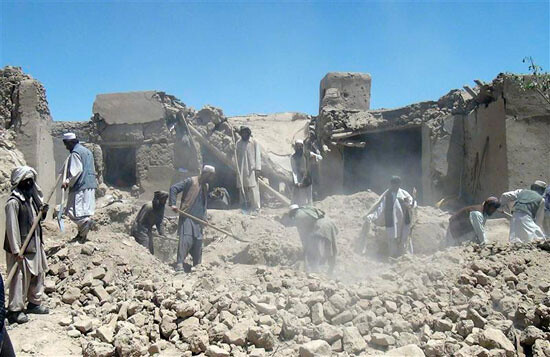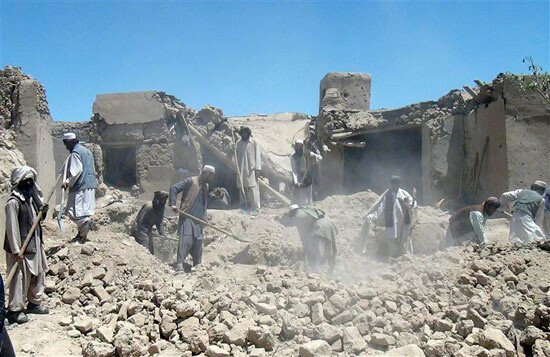It seems that the pictures we watched on TV about the American war in Afghanistan are in great need of comment. These images needed the help of language in order to speak, and yet they also couldn’t create their own language. To understand these images, we had to go back to our most primal instincts to say: this is the corpse of a child younger than four years old; that is a destroyed house; these are villagers and farmers standing at the ruins of their clay houses. Without these comments, we couldn’t understand what the villagers were doing in a particular place no different from any other save for the fact that those standing there were pointing at it. The corpses torn apart and burned with bombs, even if rare, wouldn’t point at the bombs to remind the viewer that the corpse was not a victim of a savage animal, a local fight, or an avalanche, for instance. Moreover, there was no possibility of recognizing how much time passed since the body was full of life. The few pictures presented to us of corpses did not explain what really happened, due to the small number of victims and the laziness of the press that the Taliban allowed to cover the war. All of that was there of course, but it still didn’t explain the indifference when being confronted with this death.
When the Gulf War occurred, Jean Baudrillard described it as a war without a place. And since there was no place, its material results were not real, and did not raise deep concern. There is a real need for absolute evidence that proves that this war really happened, that all the victims really did die as a result. The deaths from the war in Iraq are in this sense the deepest and most severe deaths, where group funerals were organized for children who died from a shortage of medication and food. Images of these deaths in particular were capable of leaving an effect, enough to move something inside of us, so we could begin to realize the scale of the disgrace engulfing all those who are silent. And we could say that these children did not die from the shortage of medication, but as a result of the disgrace that made us accept turning them into a lesson that both sides of the war could send to the world. The great disgrace here is not symbolic, as some would understand Baudrillard to have suggested. Rather, the disgrace can be the only reason for their deaths. Without this disgrace, no one could celebrate their deaths to prove that there are children in Iraq suffering hunger, illness, or worse, and that we should listen to their cries. In spite of this disgrace, and maybe because of it, the luck of those Iraqi children who are still alive seems much better than the luck of the Afghans who died in the midst of a cynical silence.
There are other questions that persist in the face of these wars and the objections to them. For instance, why do we worry about the death of children and not of adults? Why do we use the death of children to oppose war? Are children the only victims? Are the deaths of their fathers not acceptable and understandable? There is a potential answer in Baudrillard’s understanding of death not as fate, but as an encounter. More accurately, the definition of death as an encounter assumes that one who encounters death does so by seeking it. This is not the case for children of course, and if death was really an encounter, as Baudrillard would have it, it means that most of the dead had sought this encounter, and there is no need to feel sad for them. A person’s destiny would be to seek this encounter, not only to eventually die. Only children do not seek, and this is why we should feel sad for their death. However, the deaths that occurred in Afghanistan are no different from those that occurred in New York and Washington on the morning of September 11. And these deaths cannot by any means be described as an encounter. So how can the sorrow for New York be deeper than it is for Afghanistan? Our fundamentalist or leftist imaginations can run wild with explanations for how ruthlessly the world decides what is acceptable according to race, religion, poverty, and wealth. But this is ultimately a lazy assumption that neglects the real reasons behind this unjustifiable discrimination.
What really provokes the world are images of life and not images of death. The image wants to anticipate what is to come, as it portrays the blood that has not dried yet, the body that life has just left, so that we can feel its warmth in our own bodies. The image also wants to say that the child whose body was shattered by bombs could have lived a long life if this accident had not occurred, a life with more possibilities than the lives of those who oppose death. The image should imply the life, and not the death, of the dead person, and make us aware of the tiny moment in between. The photos of the dead children thus seem more terrible than the photos of dead men. There is something in the photos of men that always indicates their resistance and their readiness to accept death, even in their final moments. This is when life is naked, as in the case of the lives of Afghans. However, when we glimpse the dust gathering on the glasses of a survivor of 9/11 in New York, we realize that the man afraid of death was in this case not ready to encounter it.
The Afghani prepares to meet death in two ways. First, the war on the Afghani is clearly declared, at least for those who followed the news. The second is that the Afghani starts the day without any idea of how it will end, as there are no fixed jobs, and the scarcity of rain alone might devastate the whole population. That’s why the Afghani receives death naked—no differently than a few months or days ago. The American’s time is divided into seconds, minutes, and hours, through working hours, the time to wake up, get dressed, and so forth. In this way, the American declares an accurate sense of death and death’s course, and will not be surprised. On the other hand, the Afghani who lacks these means knows that today is similar to yesterday, and that time has stopped. And the person following the news thus finds it impossible to accurately determine the Afghani’s age, for they are either young fighters or old people whose lives have already ended.


There is another missing characteristic in the image of the Afghani, which makes his death old and indistinguishable. When the cameras photograph the ruins of the houses, one can’t help noticing the destroyed children’s toys and their burned beds, as well as the shattered furniture of living rooms: burned couches, chairs, and television sets. All these objects indicate the time of death, which has not yet passed, and the viewer senses that it has just taken place. This makes for a sorrowful death, and the feeling that it could have been avoided. On the other hand, the clay Afghani houses, which contain almost none of the contents mentioned above, wouldn’t allow the viewer to decide the time of death. The image of death in the midst of these houses appears very ancient and old, similar to the way Osama Bin Laden invited us to follow him and join the people of caves and grottos.
What the photos of Afghans indicate is the time of those who own television sets, and watch those who stand naked before death. We feel we can’t believe, in spite of the strong desire to, that there are human beings somewhere in the world who still live in such a way. During the 1996 “Grapes of Wrath” attack on Lebanon, Abbas Beydoun realized that the local and international media photographed the southern Lebanese with faces that did not express their age, clothing that did not indicate their bodies, and houses that did not specify the era they were living in. Beydoun commented sadly that these were not the southern Lebanese he knew, and that the media chose with cynical accuracy only the poorest people of the south living in the most primitive circumstances, just as cameras did in Afghanistan. Zahera Harb, a reporter for Lebanese television, thus became the heroine of the spectacle and the suffering of the southerners who were bombed by the Israelis, and who have not recovered even today.
In a similar way, the world did not cry for the Afghanis who died, because they did not own television sets. Their suffering produced only a few heroic journalists, who did not even deserve such an honor.
Category
Subject
Translated from the Arabic by Walid Sadek


